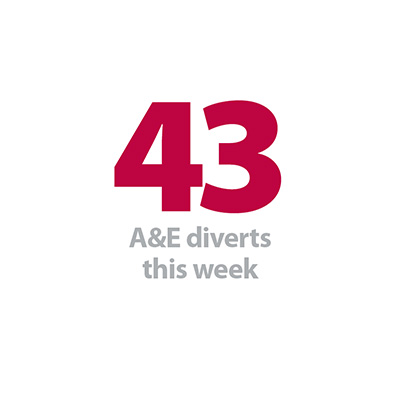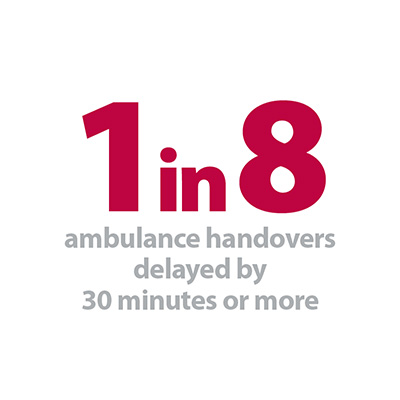


This weeks’ sitrep data shows that the pressures are stabilising since the peak in the first week of January but all the indicators still tell a story of a system under immense pressure every single day. This continues to place trusts and their staff under significant pressure.
The average bed occupancy is still sitting at over 95% – this is way above recommended safe levels. The number of ambulance arrivals has crept up from last week and this week also saw the most A&E diverts this year – 43. Despite this increase in demand, ambulance handover delays of more than 30 minutes did not rise and have stabilised for the last few weeks at around 12%.
The impact of flu that we saw at the beginning of the year has begun to ease with 7.66 admissions per 100,000 population compared to 8.86 two weeks earlier.
You can find out more about what the data means in our new explainer and download our winter sitrep dashboard to see the figures in more detail.
With only four weeks left of winter, we will continue to monitor performance. But we already know that these pressures will not just disappear once winter is over. The reality is that NHS staff are working at full stretch throughout the year.
We already know that these pressures will not just disappear once winter is over. The reality is that NHS staff are working at full stretch throughout the year.
This week, Dr Sonia Swart, chief executive of Northampton General Hospital NHS Trust, shares reflections from the patients at her trust and explains the vital role all staff are playing in both delivering and improving care in challenging circumstances.
Stories from trolleys – our patients have the answers
Winters come and go as each year the pressure intensifies and at Northampton General Hospital (NGH) despite the slight ease in the last week all our beds are still full and too often patients are waiting for one. Every winter as we worry that we are at the limit of our ability to provide safe care we manage to do just that little bit more to improve things but this winter things are tougher. Even though we have actually managed to admit fewer emergency patients, those that do come in are older, sicker and frailer and they stay longer. The number of patients in our beds for over seven days is just about the highest in the country and has been rising.
Our teams have been amazing – additional consultants at the front door, changes in working arrangements, more seven-day working, lots of clinical and support staff doing extra shifts. These are just some obvious examples. The collegiate spirit is palpable and the board of winter heroes now proudly displayed along the hospital corridor is growing. Underpinning this, our programme of quality improvement work to Fix the flow led by our chief operating officer, director of nursing and medical director is an embodiment of our view that in the NHS and certainly at NGH everyone has two jobs – to deliver care and to improve care.
At the point of the highest pressure, a multiagency discharge event supported by the emergency care improvement programme and by partners across the health and social care system was a resounding success – building understanding and trust and getting more people home with a smile. The overall message? Change is needed. Changes in the way services are delivered and commissioned, changes in our appetite for this change.
Our teams have been amazing – additional consultants at the front door, changes in working arrangements, more seven-day working, lots of clinical and support staff doing extra shifts.
Chief executive, Northampton General Hospital NHS Trust
As a CEO I find I am needing to say sorry – sorry to our staff for not having managed to fix all this and mostly sorry to patients when I know things are not working the way they should. When the pressures were at their highest one weekend, it brought the dreaded queues in corridors with ambulance crews waiting with their patients. This weekend our four-hour target performance was poor at only 80% with intense pressure to find a suitable bed for each patient.
So, what did our patients on those trolleys and their relatives tell me whilst I apologised and made enquiries? Their comments were uniformly along the lines of huge appreciation and admiration for the staff and the hospital – and yes they all knew why they were waiting. Every single patient that weekend and every set of relatives felt that the care had been good and safe. They were full of praise for hospital and ambulance services alike – with the waiting regarded as an inevitable consequence of NHS pressures.
I went on to ask them what they thought should be done to improve matters – here again there was a consistent message: more funding, more support for staff, long term planning of health independent of the political party of the day and, finally, could services be more joined up particularly with social care? So when you really want perspective as ever – ask the patients and listen.
They were right about receiving safe care at NGH that weekend. Ninety percent had their treatment started within an hour. We may have missed the four-hour target and I may have felt terrible about the delays waiting for beds but none of those patients on trolleys were left unsafe and the people who needed it were treated quickly. Not surprising to see a winter hero award for the whole of #teamED #teamNGH! We have more work to do but there is cautious optimism as we continue the quality improvement approach.
As a CEO I find I am needing to say sorry – sorry to our staff for not having managed to fix all this and mostly sorry to patients when I know things are not working the way they should.
Chief executive, Northampton General Hospital NHS Trust